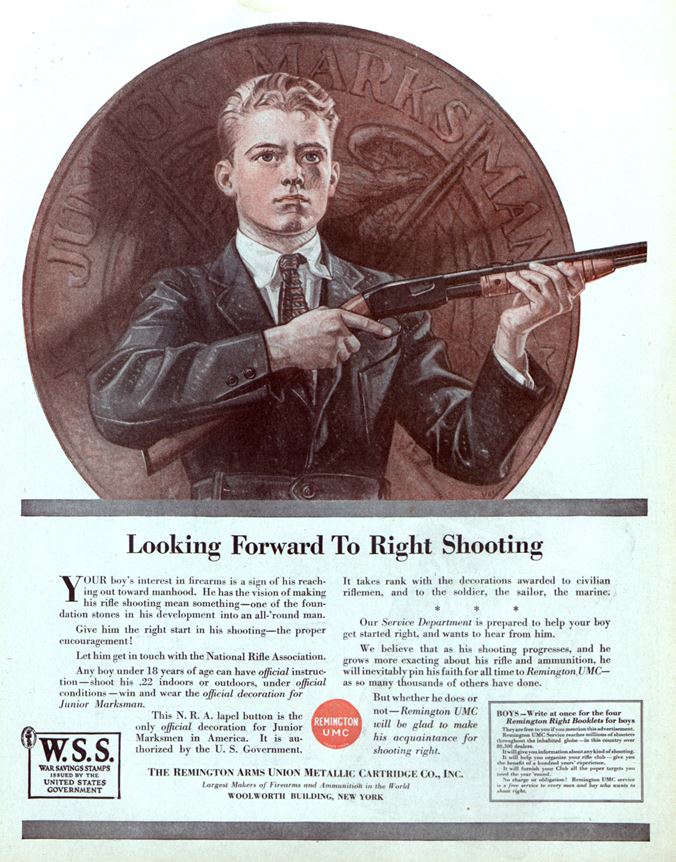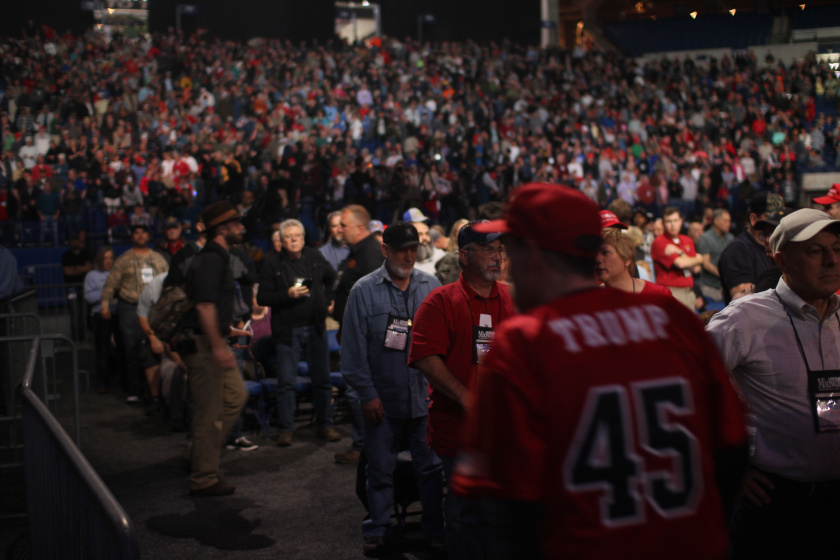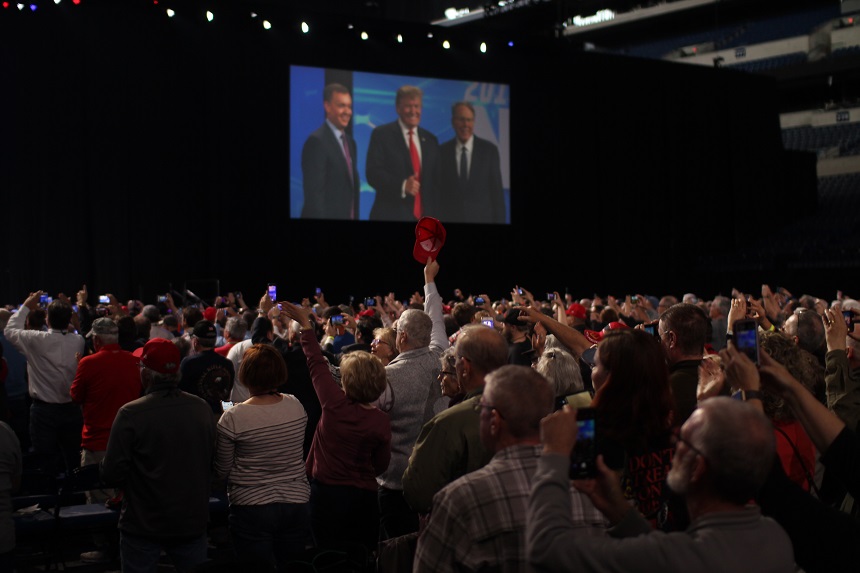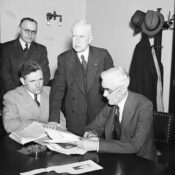Country musician Lucas Hoge was firing up a crowd at Lucas Oil Stadium in Indianapolis last Friday when he asked the audience, “Are you guys ready for a great NRA convention? It’s gonna be a good one, I guarantee you that.” Playing songs with titles like “Dirty South” and “Power of Garth,” Hoge was opening for the leadership forum put on by the National Rifle Association’s Institute for Legislative Action. The forum, featuring a speech from President Trump, kicked off the weekend of the NRA’s annual meeting — a weekend that coincided with a crisis for the organization itself.
The next day, the New York attorney general would announce an investigation into the NRA’s tax-exempt status, and NRA president Oliver North would step down, announcing that he would not seek another term in his role.
On Friday, however, the gang was all there, and the crowd was eager to hear from some of the country’s most prominent conservatives, even as reports swirled that the organization’s biggest yearly event was coming at a time of division for the NRA. The rift in the gun group’s leadership didn’t seem to bother the red-hatted spectators. An audience at an NRA convention might be one of the purest distillations of the president’s base of support.
“Where the spirit of the Lord is, there’s freedom. And that means freedom always wins,” Vice President Pence said during his speech, invoking the word “freedom” for the 35th time. He spoke with intense emphasis on each word as he decried the prospect of voting rights for prisoners and an American socialist movement.
Red and blue lights illuminated the large platform as President Trump took the stage to the tune of “God Bless the U.S.A.,” MAGA hats waving and cell phones recording all around. One cell phone was actually thrown onto the stage by a zealous fan (or protester?) who was then removed. It wasn’t a rally, per se, but it was close enough.
The tight embrace of the Trump administration to the NRA couldn’t be clearer. After all, the gun group spent well over 50 million dollars in outside spending during the 2016 election, which is just about double the amount it has spent in other election years. But their mutual enemies seem to define their alliance. As Trump points to the press section in the center of the stadium and says, “They’re fake,” boos emanate from the surrounding crowd.
Over the course of the day, the word “they” is used frequently to refer to the other side, whether that is immigrants, Hollywood celebrities, the left, or some vague combination of them all. “They hate us,” Chris Cox, executive director of the Institute for Legislative Action, said. “They hate our trucks. They hate our plastic straws. And, yes, they hate our guns.” Ted Cruz, on the media: “The men and women here, we are speaking the truth. They are speaking lies.”
As the program made its case for billing the NRA as “freedom’s safest place” and touted the organization’s long history of gun advocacy in this country, an outsider might have wondered what exactly comprises that history. Over the span of many years, the NRA transformed from a group focused on uncontroversial marksmanship training to one of the most powerful lobbying groups in Washington.
In the beginning, the NRA didn’t have enemies.
A Big Brotherhood of Rifle Enthusiasts
The National Rifle Association was formed in 1871 by two Union Army officers, Col. William Church and Gen. George Wingate, to improve shooting skills among American men. They modeled it off the British NRA, which still resembles its original incarnation. The National Rifle Association — “the big brotherhood of rifle enthusiasts” as a Lyman Gun Sights advertisement called it in 1916 — held long-range shooting competitions and focused very little on policy at the turn of the century.

In the 1920s and ’30s, as historian Jill Lepore writes in The New Yorker, “To the extent that the NRA had a political arm, it opposed some gun-control measures and supported many others, lobbying for new state laws … which introduced waiting periods for handgun buyers and required permits for anyone wishing to carry a concealed weapon.” In 1934, NRA president Karl Frederick said, “I have never believed in the general practice of carrying weapons. I think it should be sharply restricted and only under licenses.” The group supported both the National Firearms Act of 1934 and the Federal Firearms Act of 1938, two bills that came in the wake of Prohibition-era gangster violence.
In 1968, the Gun Control Act was also passed without too much resistance from the NRA. (Executive Vice President Franklin Orth wrote in American Rifleman that“the measure as a whole appears to be one that the sportsmen of America can live with.”) The bill banned mail-order sales and prohibited addicts and the mentally ill from purchasing guns. But still, it had been stripped of some fundamental proposals. Lyndon Johnson, originally having pushed for a national registry of gun owners and universal licensing in the bill, decried the opposition that blocked his additional measures, saying, “The voices that blocked these safeguards were not the voices of an aroused nation. They were the voices of a powerful lobby, a gun lobby.”
President Johnson was speaking not about Orth, but about many rank-and-file members of the NRA who had begun to organize around the defeat of gun control legislation of any kind.
Growing a Movement
In 1966, Guns Magazine began publishing articles by Neal Knox in opposition to the “Dodd Bill,” an earlier version of the Gun Control Act. “A federal agency, acting under provisions of an ‘anti-crime law’ has launched a move that may be the death knell of organized gun shows, the lifeblood of antique arms collecting,” Knox wrote. There was no mention of the Second Amendment in those years. Knox seemed to be more concerned about the massive inconveniences that gun control could bring to “law-abiding” gun owners and dealers, as well as the possibility that the government would take a mile if given an inch.
When agents of the Bureau of Alcohol, Tobacco, and Firearms shot and paralyzed NRA member Kenyon Ballew, in 1971, Knox’s fears seemed to be confirmed for many in the group. The ATF agents conducted a raid to confiscate a stockpile of illegal grenades, and they rammed in his door to find the veteran naked and wielding a replica of an 1847 Colt revolver. Ballew was not prosecuted, but a federal court ruled against his own lawsuit since the explosives were found in his home. The NRA’s American Rifleman published a six-page story headed “Gun Law Enforcers Shoot Surprised Citizen, Claim Self-Defense,” and for years afterward, according to James Moore’s account, Very Special Agents, Ballew “was wheeled to gun shows and put on display — head hanging, face slack, mouth drooling — with a sign hung around his neck: ‘Victim of the Gun Control Act.’”
Hard-line views on gun rights fermented among NRA members until the disparity of interests between the organization’s leadership and membership came to a head in 1977. That year, in Cincinnati, the NRA’s annual meeting was taken over by a group of blaze-orange-cap-wearing members led by Knox and former U.S. Border Patrol leader Harlon Carter. They had gathered support to vote out executive vice president Maxwell Rich and install Carter. While the old guard of the NRA was interested in moving out of D.C. and away from politics, Knox and Carter — director of the recently formed lobbying wing, the Institute for Legislative Action — wanted to plunge the group headfirst into a fight for gun rights with a new strategy: “No compromise. No gun legislation.” There was a new motto as well: “The Right of the People to Keep and Bear Arms Shall Not Be Infringed.”
The hard-liners had studied the organization’s bylaws and carried out a grassroots organizing effort to use the annual meeting to oust their leaders and change the direction of the NRA. After a meeting that lasted until 4 a.m., Knox and Carter’s constituency was successful, and the new direction of the NRA was official.
Throughout the ’80s and ’90s, the NRA grew its membership alongside a fairly novel understanding of the Second Amendment. In 1986, the Firearms Owners’ Protection Act was passed by Congress, which rolled back many of the restrictions passed in 1968. The Violent Crime Control and Law Enforcement Act of 1994 banned many semi-automatic weapons, to the annoyance of the NRA, but its ban on “assault weapons” expired after 10 years and was not reinstated.
An Uncertain Future
These days, the NRA has a friend in the White House, but mass shootings in recent years have bolstered support for gun control advocates. For the first time, during the 2018 midterm election, gun control groups spent more money than gun rights groups.
A few weeks ago, the NRA sued Ackerman McQueen, the public relations firm that has been forming the organization’s sharp messaging for decades. Ackerman McQueen is responsible for the online channel NRATV, which has drawn scrutiny for drifting into far-right programming that has little to do with gun ownership or policy. The lawsuit came after the NRA claimed its PR firm refused to provide financial documents.

The NRA is also seeing shrinking contributions, and the group found its finances in the red for a second consecutive year in 2017. In six of the last 10 years, the group has spent more than it has taken in, with 2017 seeing its largest deficit.
“Let me make this really personal,” Oliver North said on the Indianapolis stage last Friday as he asked for help in doubling the NRA’s current membership of 5 million, to double the group’s strength and political clout. And since North was “fond of talking to and about God,” he asked for prayers for the NRA.
“On one side are those who seek power, control, and domination, and on the other side are patriots like us,” Trump said. The president made his way through a checklist of likely topics, from immigration to the Mueller report to the prospect of arming teachers (“Who is better to protect our students than the teachers who love them?”), then he signed a document rejecting the UN Arms Trade Treaty onstage and threw the pen into the crowd. “We will never allow foreign bureaucrats to trample on your Second Amendment freedoms,” Trump said of the treaty designed to regulate international sales of conventional arms.
Chris Cox was visibly pleased about Trump’s announcement. As he attempted to ready the room for the next speaker, Steve Scalise, people began to clear out. The main event was over, after all. Wayne LaPierre, the long-time CEO of the NRA, spoke, as well as Kentucky Governor Matt Bevin. Each man stressed the irredeemable rift that lies between card-carrying members of the NRA and the people who want to take away their guns: the left, liberals, Hollywood, billionaires.
The roughly 50-year-old notion of “no compromises” on gun rights in the NRA has grown into a full-fledged cultural mindset that seems to need enemies to thrive. Unlike 100 years ago, when the only enemy the group fought against was the misuse of firearms, the NRA and its advocates keep a long list of current nemeses that must be battled like supervillains.
“The left and the press can’t make the fundamental distinction between good guys and bad guys,” Cruz said. “At the end of the day, this ain’t complicated. There are good guys and bad guys.” The implication was that everyone in the room — NRA members and representatives, at least — were the law-abiding citizens, the patriots, the “real Americans.” The good guys.
Photos by Nicholas Gilmore
Become a Saturday Evening Post member and enjoy unlimited access. Subscribe now




Comments
Well, at this late date something’s got to give with the NRA. All of the mass shootings from the ’90s-present have to finally be taking their toll on the powerful organization. We know there have been 2 high profile ones just since that convention; Sunday in CA., and Tuesday in NC.
Then there’s the matter of personal responsibility and accountability. I read the latest ‘You Be The Judge’ last night in the May/June issue. This particular case involves the equally common accidental shooting and is very timely. A loaded gun visibly left on the front seat of an unlocked truck. A teenage boy chooses to break into the truck, steal the gun, and then winds up accidentally shooting his best friend. If this boy had not been underage (a technicality) he would have had to face a lot more responsibility of his role in this tragedy; not just the irresponsible gun owner. Plenty of blame to go around.
On a semi-related note, we have the ACLU and the 180 they’ve done from their original mission. If someone breaks into your home and tries to kill you, the ACLU will be on the side of the criminal and their rights, not you, the victim, and your rights.
I’ve heard over the years that if a criminal is injured in the course of committing a crime in your home and property, they can sue you for any harm they may experience, and the ACLU will be right there at their side defending them. This is why you hear if you (justifiably) kill them in self defense, the body HAS to be inside your house. If they’ve got even one foot out the door, you have to pull the damn body inside before calling 911 to cover your @##.